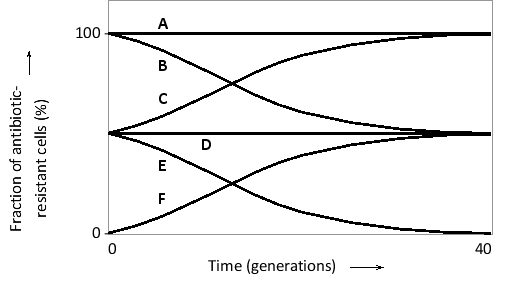Two haploid budding yeast cells are allowed to mate. One of them carries a mutation in its mitochondrial DNA that makes the yeast cell resistant to an antifungal drug. If the resulting diploid zygote is allowed to propagate (in the absence of the drug), how do you predict that the fraction of drug-resistant cells will change over time in the population? Choose the best curve (A to F) from the following graph. Note that the "population" is only composed of one cell at the beginning of the experiment. The curves are smoothened to cancel stochastic fluctuations that happen at such low population sizes. 
Definitions:
Bipolar Disorders
A mental health condition characterized by extreme mood swings, including emotional highs (mania or hypomania) and lows (depression).
Imipramine
A tricyclic antidepressant used to treat major depression, enuresis, and sometimes panic disorder.
Interpersonal Psychotherapists
Therapists specializing in a treatment form focusing on interpersonal relationships and mental health issues.
Beck's Cognitive Therapy
A form of psychotherapy developed by Aaron T. Beck that aims to identify and help change potentially self-destructive or unhealthy cognitive distortions and behaviors.
Q1: Which of the following morphological changes is
Q2: Indicate true (T) and false (F) statements
Q14: How is Cdc20-APC/C similar to Cdh1-APC/C?<br>A) They
Q16: Which of the following molecules can serve
Q16: Which of the following is a primary
Q26: While examining the crystal structure of a
Q26: Indicate true (T) and false (F) statements
Q27: A certain region of a mammalian genome
Q27: Indicate true (T) and false (F) statements
Q34: Once expressed in a neuron in the